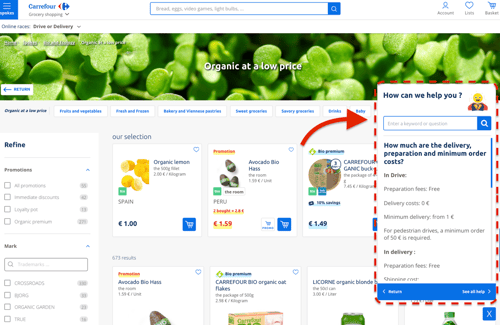
A chatbot, or bot, is a computer programme which simulates natural human conversation to enable dialogues with users over the internet. Companies frequently use bots to automate interactions with their customers in order to reduce the contact rate with their customer service departments. In fact, it’s predicted that AI chatbots will power 95% of customer interactions by 2025.
So, where do you start if you want to create a chatbot?
Technical questions aside, a chatbot is first and foremost a strategic tool for customer relationship management. Every chatbot project must be based upon a formalised strategy.
In this article, we have listed the major questions you should ask in order to reach your objectives and ensure the success of your chatbot project.
Table of content
1 - What purposes should your chatbot fulfil?2 - Who is the chatbot for?
3 - Which type of chatbot should you choose?
4 - What questions should the chatbot be able to answer?
5 - How can I build a sufficiently rich knowledge base?
6 - Which personality should be attributed to the chatbot?
7 - How should the chatbot conversational flow be structured?
8 - How to integrate a chatbot into its web ecosystem?
1 - What purposes should your chatbot fulfil?
Chatbots revolutionise interactions with customers. They are constantly available and respond to your customer’s needs of immediacy and autonomy. But the possibilities offered by a new technology can sometimes distance brands from their real business objectives.
It’s easy to let yourself be dazzled by the technology and want to multiply the functionalities of your chatbot - but don’t lose sight of your objectives.
Even with the greatest technology, a chatbot project will fail if it doesn’t respond to a specific objective from the outset. In other words, a CRM-oriented chatbot shouldn’t have the answers to everything. It should be designed to respond to specific objectives.
Reducing the contact rate to customer service departments is the obvious objective for this type of chatbot. But the project could also be based on customer satisfaction objectives. For example, the Customer Effort Score (CES) could be used as a KPI.
2 - Who is the chatbot for?
Who are your customers? What are their problems? What is their relationship to technology? What are their expectations with regard to the functions of a chatbot?
These questions must be asked before beginning the process of putting a bot in place. If you don’t precisely define your target audience, you run the risk of seeing your chatbot under-utilised by your customers.
This is crucial, because a bot won’t interact in the same way if it’s speaking with young people between 18 to 25 years or with retirees. The way it formulates its responses, the rhythm and tone of its voice: these must all be adapted to your target audience. Likewise, if the bot is addressing a specific professional category, a specialised vocabulary must be adopted.
In principle, this reflection on customer profiles predates the creation of a chatbot. Quite logically, it is the base upon which all content strategy is built. We can therefore rely on the definition of marketing personas. It is important, however, to identify whether the bot addresses a particular segment and to determine at which stage of the client journey the bot may intervene.
3 - Which type of chatbot should you choose?
There are two types of chatbots:
- Simple or scripted chatbots are designed to respond to specific questions. They follow conversational scripts, using scenarios prepared in advance.
- Complex or learning chatbots rely on artificial intelligence (AI) also referred to as an AI bot. An AI chatbot is capable of understanding and analysing human language in order to provide contextualised responses thanks to artificial intelligence.
The choice will depend upon your chatbot project objectives and your budget.
However, complex and simple chatbots (which blend scripts and artificial intelligence) are becoming more accessible overall.
The other question currently being raised is the choice between an ai chatbot and a voicebot. Here again, deep knowledge of your target audience and their specific needs will show you whether or not to give priority to voice over chat.
4 - What questions should the chatbot be able to answer?
If you decide that the reduction of contact rate with customer service is your objective, the response to this question may seem fairly simple.
The chatbot must respond to the most frequent customer requests.
Consequently, prior to creating a chatbot, the project manager and all associated teams must list all of the questions most frequently asked of the customer service department.
But when you first create a chatbot, be careful not to try to do too much. It’s better to focus on the most recurrent use cases. And only once these have been perfectly mastered should new functions or new conversations be added. It’s not only necessary to list all the most common questions, but also to prioritise them with regard to the volume and complexity of each required response.
5 - How can I build a sufficiently rich knowledge base?
How can you ensure that your chatbot responds correctly to the questions customers ask?
You need to constitute a knowledge base that consolidates all the best responses to each of the questions that the bot must handle.
To create a knowledge base, you can:
- Use an existing source: you could, for example, adapt and reformat an existing FAQ to create a simple chatbot.
- Recover content from internal databases: there are tools available to extract data from your existing computer systems. But this method entails additional costs. And after extraction, the next challenge consists of classifying and formatting the data to make it usable by the chatbot.
- Create a new source: there are different ways to go about this: generalise the best customer service response to a question based on existing statistics, and/or conduct a question-and-answer session with a group of target customers.
If you want to know more about some knowledge base use cases, don't hesitate to read our article 100+ Best Knowledge Base Examples and Tips to Create Yours.
But before selecting one of these methods, their cost and anticipated ROI must be estimated.
6 - Which personality should be attributed to the chatbot?
The raison d’être of chatbots is to be able to dialogue with customers. But in order for their interaction to succeed, the conversation must seem as natural as possible.
To enable this, the chatbot must be given a coherent personality. But on which bases?
First of all, the chatbot must be a reflection of the company and, in particular, of the company’s conception of its customer relations. The bot will share the same character as that expressed by all the other elements of the brand. The personality of the bot must also adapt to the target audience to which it will speak. Certain audiences will need to be guided. In these cases, the bot will be more didactic. For other types of customers, those more comfortable with the technology, we can adopt a more casual tone.
7 - How should the chatbot conversational flow be structured?
How can a chatbot be programmed to effectively simulate human conversations?
The challenge to create a chatbot is threefold:
- Disseminate “knowledge”, the expertise of the customer service department;
- Reflect the tone of the brand;
- Interact in “the most human way possible”.
The structuring of flows also depends upon the type of chatbot.
In the case of a scripted chatbot, all conversation diagrams, called “decision trees” or scenarios, must be planned in advance. All possible questions/responses will be anticipated and tested upstream. Assistance or alternatives will always be provided in order to avoid impasses. Generally speaking, interactions will always be semi-guided. Learning chatbots operate differently because they’re capable of giving personalised and contextualised responses. They feed off of prior conversations in order to enhance the flow and quality of their responses.

8 - How to integrate a chatbot into its web ecosystem?
You can create the best chatbot and still fail. This is what could happen if you don’t integrate your chatbot correctly into its web ecosystem.
For a chatbot to meet its objectives, it must be easily accessible for the user. That means highlighting it with adapted calls-to-action. And the chatbot must be proposed to the user at the right time throughout the customer journey. In this way, it won’t appear as a “gadget” but as a tool to enhance the customer experience.
One last question: should the chatbot appear only on the company website? Should it also be accessible on the company’s social media? Should a mixed solution be envisioned? In the logic of an omnichannel approach, it is imperative to answer these questions before making the leap to making a bot.
The rapid development of chatbots shows that they represent a force to be reckoned with in terms of customer relations. Bots have become an element of customer satisfaction and brand differentiation. Before launching one, it’s vital to understand the disastrous effects that a “bad” chatbot might bring about: loss of credibility, negative brand image, loss of customers. This is why it is vital to handle the creation of a chatbot as a strategic project and not as a simple technical operation.


.png)



